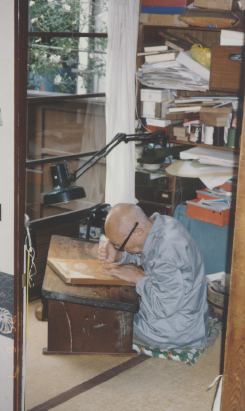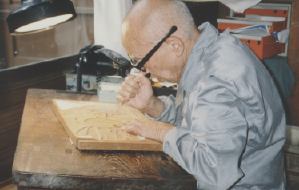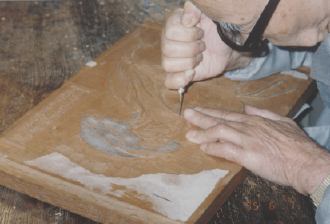Visit to ... Ito-san, the carver
Mr. Susumu Ito, carver
It is the bench that immediately captures my attention as we step into the room. It is wide and low, made from hard, heavy keyaki wood, battered and scarred from decades of daily use, with the top surface deeply burnished by rubbing from the cloth that protects the back surface of the woodblocks. It stands in front of the window overlooking the garden, and the diffused light from today's overcast sky falls softly over the half finished woodblock resting on its surface, throwing the carved lines into clear relief.
 A carving knife, the wood of
the handle also polished by long use until it glows, lies on the
bench next to the block where the carver has put it down to turn and
greet us. The workbench, the woodblock, the knife ... they make up a
picture the details of which have not changed in more than a hundred
years, in far more than a hundred years. My friend Sadako and I have
come to see this picture, and to hear some of the story to be told by
Mr. Susumu Ito, master woodblock carver, working here at his home
tucked away in the narrow back streets of Arakawa-ku, in Tokyo's
shitamachi district.
A carving knife, the wood of
the handle also polished by long use until it glows, lies on the
bench next to the block where the carver has put it down to turn and
greet us. The workbench, the woodblock, the knife ... they make up a
picture the details of which have not changed in more than a hundred
years, in far more than a hundred years. My friend Sadako and I have
come to see this picture, and to hear some of the story to be told by
Mr. Susumu Ito, master woodblock carver, working here at his home
tucked away in the narrow back streets of Arakawa-ku, in Tokyo's
shitamachi district.
He has been living and working there in this house, here in this tiny 2-mat room, for more decades than I have been alive ... many more. For most of his 80-odd years, ever since first picking up the carving tools at age 12, he has sat in front of such a workbench, gripping the delicate knife in his right hand, almost burying it in his grip, and carving, carving, carving ... How many blocks have passed over the surface of this bench? How many prints has he made? It has never occured to him to try and answer that question. For Ito-san, this is simply his job, his daily work.
Before leaving my home today to come to this place, I had spent some time studying a particular print I own, a reproduction of a famous Utamaro design. Had studied the delicate, almost invisible hair lines surrounding the face of the woman depicted, the flowing curves of the lines of the fabrics, the smooth sharp lines of the fan she is holding ... all these lines carved by Ito-san at this very bench some years ago. Carved with supreme confidence, and with a skill which I sometimes despair of ever reaching.

When, during our visit, I show Ito-san some of my own prints, and one of my carved blocks, I suddenly find that now, as I sit here next to him in this room, the work that I had thought was actually 'not too bad', somehow has come to look clumsy and amateurish. He looks them over - for quite a long time - and makes some very kind comments, but I have to wonder what he really thinks of all this; of this foreigner who is trying to follow such a path.
During our conversation, he uses a number of times the expression 'shumi', hobby, when talking about my work, but he is not doing so in a patronizing way. Rather, he is trying to express the idea that unlike him, I am free to truly enjoy the work that I am doing, by choosing what to carve, how to print it, where to sell it, etc. etc. For Ito-san, on the other hand, the word that must be used is 'shigoto', work. It is not for him to ask those questions, but simply to accept whatever jobs come from the publishers. He has carved and re-carved the same popular Hiroshige or Hokusai prints many times over, and yet he would not think to complain about the repetition. He is a carver ... and it is his job to carve ... For myself, I could not conceive of doing the same print again and again. But I am not really a 'shokunin'. Even though I make a living at this work, I am still a kind of an 'amateur' at this; an amateur in the original French sense of the word - one who 'loves' ...
 But I am sure that Ito-san too,
loves his work. He doesn't 'think' about it anywhere near as much as
I do, and on a number of occasions during our conversation, he had to
pause and think twice before responding to something I had asked, as
he had never before considered such matters. Woodcarving is not an
intellectual pursuit for him, but simply a way of life. He eats,
breathes ... and carves.
But I am sure that Ito-san too,
loves his work. He doesn't 'think' about it anywhere near as much as
I do, and on a number of occasions during our conversation, he had to
pause and think twice before responding to something I had asked, as
he had never before considered such matters. Woodcarving is not an
intellectual pursuit for him, but simply a way of life. He eats,
breathes ... and carves.
Ito-san told us that when he started in this craft, there were upwards of 250 men making a living carving blocks, but thought that there were perhaps now only about ten or so. Whether or not this number will decrease even further, or remain stable, seemed to bother him not at all. This quiet, contented man does not seem overly concerned with the doings of the world outside his window. His world is here in this tiny room, in the drawers full of tools, and in the woodblock waiting on the bench ... I am sure that not two minutes after we had departed, taking our 'noisy' questions with us, he was back sitting on his zabuton, his nose not 10 centimeters from the surface of the wood, his entire concentration focused on the knife slicing its way through the hard cherry wood. He is a carver ... and it is his job to carve ...
I am only half Ito-san's age, and have been carving less than a quarter of the number of years that he has worked. Even though I sometimes feel pride about my developing skills, a visit such as today's makes me realize that I am still very much a beginner. Many more years will have to pass by before I can honestly call myself a carver. When I am in my 80's, will I still be sitting at a bench such as this, holding a knife like this, carving smooth lines like this? I cannot answer such a question. It is impossible for me to create such a picture in my mind. I am still too young. But of one thing I am sure - that of all the possible futures that lie in front of me, I can think of very few that seem so satisfying as this one ...
Ito-san, congratulations on making such a happy productive life for yourself. May your coming years be full of peaceful contentment thinking over the time so well spent ...
Editor's Note: this story was written in 1995; Mr. Ito passed away in December of 1998, and will be greatly missed by all of us who knew him.
